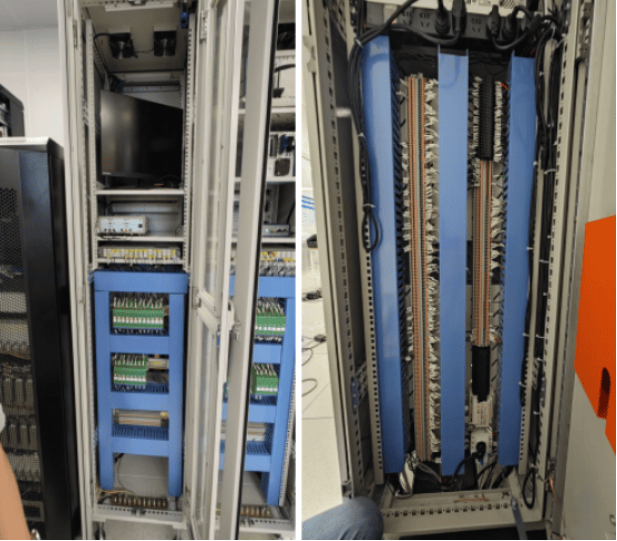Aero Engine Test Bed Upgrade Using DE-918 System
I. Project Background and Objectives
In August 2024, an aero engine design research institute under China Aeroengine Group comprehensively upgraded the test system of the 601 test bed to improve the data accuracy and reliability of the XXX-type engine test. The upgrade focused on multi-parameter comprehensive verification, including ignition characteristics, thrust performance, temperature distribution, pressure pulsation, flow monitoring, and speed stability. By introducing the DE-918 High-Immunity Isolated Data Acquisition System, the project addressed the challenge of weak signals being susceptible to interference in traditional testing, ensuring data accuracy and stability in complex electromagnetic environments.
II. Upgraded Test System Solution
1. Multi-Parameter Synchronous Monitoring System
Sensor Configuration:
Temperature Sensors: Installed in key areas such as the combustion chamber and turbine inlet/outlet to monitor thermal distribution.
Pressure Sensors: Mounted in the compressor section, fuel pipelines, and tail nozzle to capture dynamic pressure.
Flow Sensors: Integrated into the fuel and air supply systems for real-time medium flow measurement.
Thrust Sensors: High-precision strain-based thrust load cells to measure net engine thrust.
Speed Sensors: Monitored high-pressure/low-pressure rotor speeds, correlating vibration and performance parameters.
Signal Channels: A total of 200+ channels deployed to cover full-system physical quantity monitoring.
2. Core Acquisition Equipment: DE-918 System
High-Immunity Design:
Isolated signal conditioning technology with a common-mode rejection ratio (CMRR) >120 dB, effectively isolating ground loop interference.
Shielded chassis and filter circuit design to resist strong electromagnetic fields and inverter noise in the test bed.
High-Performance Specifications:
18-bit ADC resolution with a maximum synchronous sampling rate of 256 kS/s.
Support for TEDS sensor automatic recognition and calibration, reducing human configuration errors.
Real-Time Data Processing:
Built-in algorithms for real-time calculation of engineering parameters such as corrected thrust and thermal efficiency.
Data streams synchronized to the control room display via Gigabit Ethernet.
III. Test Content and Data Value
1. Comprehensive Test Conditions
Ignition Test: Monitored pressure/temperature transients during startup to evaluate ignition reliability.
Thrust Test: Step loading from idle to maximum thrust to plot thrust-fuel consumption curves.
Pulsating Pressure Test: Analyzed combustion stability and surge margins.
Thermodynamic Performance: Calculated engine efficiency using temperature/flow data.
2. Key Data Results
Improved Thrust Accuracy: Measurement error <0.1% (compared to 0.5% with traditional systems).
Noise Suppression Effect: Signal noise reduced by 20 dB compared to traditional systems, with no distortion in weak signals (e.g., strain gauge outputs).
Real-Time Fault Warning: Potential surge risks identified 10 seconds in advance through pressure pulsation spectral characteristics.
3. Design Validation Value
Data matched the XXX-type engine digital twin model with 98% accuracy, accelerating design iterations.
Established a multi-dimensional database of "performance-structure-thermal management" to support future model optimization.
IV. Core Advantages of the DE-918 System
Military-Grade Reliability
Complied with GJB 3947A-2009 military electronic test equipment standards, suitable for high-temperature and high-vibration environments.
Modular design supported hot-swappable channels, improving maintainability by 50%.
Smart Integration Capability
Seamless integration with platforms such as LabVIEW and MATLAB for customized analysis workflows.
Generated calibration reports compliant with ASTM E74 and ISO 5167 standards.
V. Customer Benefits
Improved Data Credibility: High-immunity technology ensured the authenticity of key parameters (e.g., micro-pressure differences, small strains).
Optimized Test Efficiency: Multi-disciplinary data acquired simultaneously in a single test, reducing the need for repeated tests.
Technical Risk Management: Early warning of potential failures through high-precision data, reducing test safety risks.
VI. Industry Application Prospects
This solution can be extended to:
Standardized Construction of Aero Engine Test Beds;
Comprehensive Performance Testing of Gas Turbines;
Ground Testing of Aerospace Propulsion Systems.

